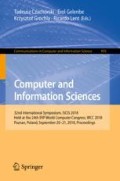Abstract
In the paper, the authors presented the concept and elements of implementation of the subsystem to support the training process of operators of the anti-crisis system. It was made in the form of emulators of hazard monitoring systems for the needs of an IT system supporting the analysis of threats in the form of CBRN (Chemical, Biological, Radiation, Nuclear) contamination, forecasting their effects and alerting the population (WAZkA).
The genesis of building the emulator subsystem is the need to provide a tool to support the training process of people involved in the activities of the National System of Detection of Contamination and Alarming (KSWSiA) in Poland. However, the emulators designed in this way can also be used as a tool to support the development of emergency procedures.
Emulators were proposed as IT tools. A constructive simulation was chosen as the emulation method, but reduced to a simple, determined data delivery in accordance with the previously prepared scenario.
Access this chapter
Tax calculation will be finalised at checkout
Purchases are for personal use only
References
Binek, T., Czepiel, J.: The national system of contamination detection and alarm. Curr. Oper. Pol. BiTP 36(4), 15–24 (2014)
Bowman, W., Woods, D.: Emulation of multivariate simulators using thin-plate splines with application to atmospheric dispersion. SIAM/ASA J. Uncertain. Quantif. 4, 1323–1344 (2016)
Gelenbe, E., Wu, F.-J.: Large scale simulation for human evacuation and rescue. Comput. Math. Appl. 64(12), 3869–3880 (2012)
Grabowski, D., Kurowski, W., Muszynski, W., Rubel, B., Smagala, G., Swietochowska, J.: Radiation monitoring network in Poland. Nukleonika 46(4), 147–149 (2001)
Greenberg, A., Small, R., Zenyuh, J., Skidmore, M.: Monitoring for hazard in flight management systems. Eur. J. Oper. Res. 84(1), 5–24 (1995)
Li, X.L., et al.: Framework for emergency decision exercise system of urban crisis based on Wargaming. Appl. Mech. Mater. 373–375, 1139–1143 (2013)
Lipiński, P., Isajenko, K., Biernacka, M., Żak, A.: Integration of polish monitoring networks (ASS-500 and PMS systems). Nukleonika 46(4), 143–146 (2001)
Manatakis, D., Nennes, M., Bakas, I., Manolakos, E.: Simulation-driven emulation of collaborative algorithms to assess their requirements for a large-scale WSN implementation. In: Proceedings of the 2014 IEEE International Conference on Acoustics, Speech and Signal Processing (ICASSP), IEEE Explore (2014)
Tarapata, Z.: Models and algorithms for knowledge-based decision support and simulation in defense and transport applications. Military University of Technology, Warsaw (2011)
Tarapata, Z., Antkiewicz, R., Chmielewski, M., Dyk, M., Kasprzyk, R., Kulas, W., Najgebauer, A., Pierzchała, D., Rulka, J.: A computer system for CBRN contamination threats analysis support, prediction their effects and alarming the population: polish case study. MATEC Web Conf. 125, 02012 (2017). https://doi.org/10.1051/matecconf/201712502012
Waszkowski, R., Nowicki, T., Saniuk, A.: Human-computer interaction in sanitary inspection simulation exercises. In: Soares, M., Falcão, C., Ahram, T. (eds.) Advances in Ergonomics Modeling, Usability & Special Populations. Advances in Intelligent Systems and Computing, vol. 486. Springer, Cham (2017)
Yin, H., Song, D.: Automatic Malware Analysis. An Emulator Based Approach. Springer, New York (2013)
WAZkA Project Homepage, http://wazka.wat.edu.pl/. Accessed 5 June 2018
Acknowledgements
This work was partially supported by grant Noo DOB-BIO7/12/01/2015 of Polish National Center for Research and Development (NCBiR) titled “Integration and support of information management processes and decision optimization in warning and alarm system” [13] and Statutory Research Work of Institute of Computer and Information Systems, Cybernetics Faculty, Military University of Technology in Warsaw, Poland.
Author information
Authors and Affiliations
Corresponding author
Editor information
Editors and Affiliations
Rights and permissions
Copyright information
© 2018 Springer Nature Switzerland AG
About this paper
Cite this paper
Kulas, W., Tarapata, Z. (2018). An IT Tool to Support Anti-crisis Training in WAZkA System: A Case Study. In: Czachórski, T., Gelenbe, E., Grochla, K., Lent, R. (eds) Computer and Information Sciences. ISCIS 2018. Communications in Computer and Information Science, vol 935. Springer, Cham. https://doi.org/10.1007/978-3-030-00840-6_18
Download citation
DOI: https://doi.org/10.1007/978-3-030-00840-6_18
Published:
Publisher Name: Springer, Cham
Print ISBN: 978-3-030-00839-0
Online ISBN: 978-3-030-00840-6
eBook Packages: Computer ScienceComputer Science (R0)

